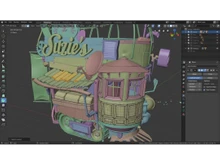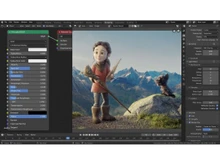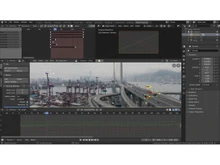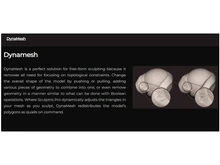Two of the most widely used 3D modeling and sculpting software packages are Blender and ZBrush. They're both cutting-edge modeling and animation software used to produce various animation styles. Other than that, both have strong sculpting functionalities, along with visual effects and texturing. While both solutions offer an extensive list of capabilities and features, there are some significant distinctions between them.
We have made a detailed comparison between these software based on pros & cons, features, user experience, pricing, system requirement, and more.
Blender vs ZBrush: Overview
ZBrush, a sculpting software, is used for the purpose of digital sculpting. It offers advanced tools to design the best quality models. The best part of this software is that it combines 2.5D as well as 3D modeling along with different textures. Apart from that, it is available for Mac OS and Windows operating systems.
Blender, on the other hand, is an open-source and free animation software written in various programming languages including C++, C, Python, etc. It offers multiple features like sculpting, rigging, modeling, UV unwrapping, and more.
Blender and ZBrush: Pros & Cons
- While ZBrush and other ZBrush alternatives have a more conventional workflow, Blender uses a node-based approach.
- The renderer in Blender is a strong and flexible tool that generates renders of excellent quality. However, rendering in ZBrush is quite basic.
- There is a sizable community of Blender users that exchange resources and tutorials. ZBrush’s community is not as active as that of Blender.
- Blender and other Blender alternatives keep on bringing new updates frequently. However, ZBrush's updates are less frequent than that of Blender.
Blender vs. ZBrush: In Terms of Features
ZBrush and Blender offer more or less similar features. However, some of the features offered by ZBrush are comparatively more advanced than Blender. These features include Subdivision, Morph Targets, Alphas, and more.
- Dynamic Subdivision: ZBrush supports dynamic subdivision which allows users to easily sculpt their models at HD resolution without impacting the performance of their system. This feature is however not that advanced in Blender.
- Morph Targets: ZBrush’s Morph Targets enable users to create and save model’s multiple versions. These variations can later be blended with other variations to create newer ones. This helps in creating facial expressions and animations.
- Game Engine Integration: Blender offers integration with multiple game engines including Unreal Engine & Unity. Using this, you can prepare 3D models for games.
- Alphas: ZBrush offers Alpha stamps but Blender doesn’t. These stamps help create patterns and textures to add proper detailing to models.
- Node-Based Rendering: The Cycles renderer in Blender is based on nodes that provide you with extensive control over how your renders will appear. In contrast, ZBrush's renderer is simpler and more conventional.
- Physics Simulation: Realistic HD-quality animations can be made with ZBrush's built-in physics simulation engine. This helps in the simulation of elements like fluids, rigid bodies, and textiles. You won’t get this feature in Blender.
- Python Scripting: Python scripting is supported by Blender, enabling task automation to help you avoid wasting a lot of time. This feature is however present in ZBrush but is not as advanced as Blender.
- Polycounts: Although Blender can work with a variety of polycounts, ZBrush is better suited for high-poly objects. Because it was created primarily for high-poly model creation, ZBrush can manage polycounts that are 10–50 times larger than what Blender can handle.
Comparison of Blender vs. ZBrush in Terms of Pricing
While ZBrush is a commercial software that needs a paid subscription, Blender is an open-source, free software. Those looking for the latest features should consider ZBrush, while those on a tight budget often prefer Blender.
Blender vs ZBrush: User Experience
Compared to ZBrush, Blender features a more user-friendly and intuitive interface. It is because Blender is based on the node-based workflow that makes it simple to analyze connections between different objects. On the other hand, ZBrush’s interface is more conventional, and it becomes challenging to use it. As Blender is simpler to learn, it can be a better option if you're a novice.
Simply put, in terms of user interface, Blender is an ideal option for beginners as it has a simple learning curve. Therefore, it becomes easier for them to use it.
Blender vs ZBrush: Application
For a variety of 3D applications, such as modeling, simulation, animation, rendering, and texturing, Blender is a good option. For sculpting, especially those requiring fine detail, ZBrush is a good option. If we talk about the quality of output, then ZBrush is a better option as it helps in bringing finer details to objects and models.
Blender vs ZBrush: Platforms Supported/System Requirements
In terms of system requirements, Blender is a better option as it supports multiple operating systems including Windows, macOS, and Linux. On the other hand, ZBrush doesn’t support Linux OS. Apart from that, the RAM of Blender is higher than that of ZBrush.
ZBrush:
- Operating System: Windows Vista (64-bits) or the latest version, Mac OSX (10.11) or the latest version
- Hard Drive: 8GB Min
- RAM: 4GB-6GB
Blender:
- Operating System: Windows 7 (64-bits) or the latest version, Mac OSX (10.13) or the latest version, Linux
- Graphics Card: Min 1GB
- RAM: 4GB-16GB
Which Is Better: Blender or ZBrush?
After a complete analysis, we can say that Blender is a wonderful alternative for someone who is looking for open-source and free 3D software with a bunch of features. ZBrush, on the other hand, is an excellent choice for you if you want to specialize particularly in sculpting. Pricing-wise, Blender is a winner as it is free to use. But functionality-wise, ZBrush wins the league with advanced features like polycounts, morph targets, physics simulation, and more.


 3 Ratings & 3 Reviews
3 Ratings & 3 Reviews

























